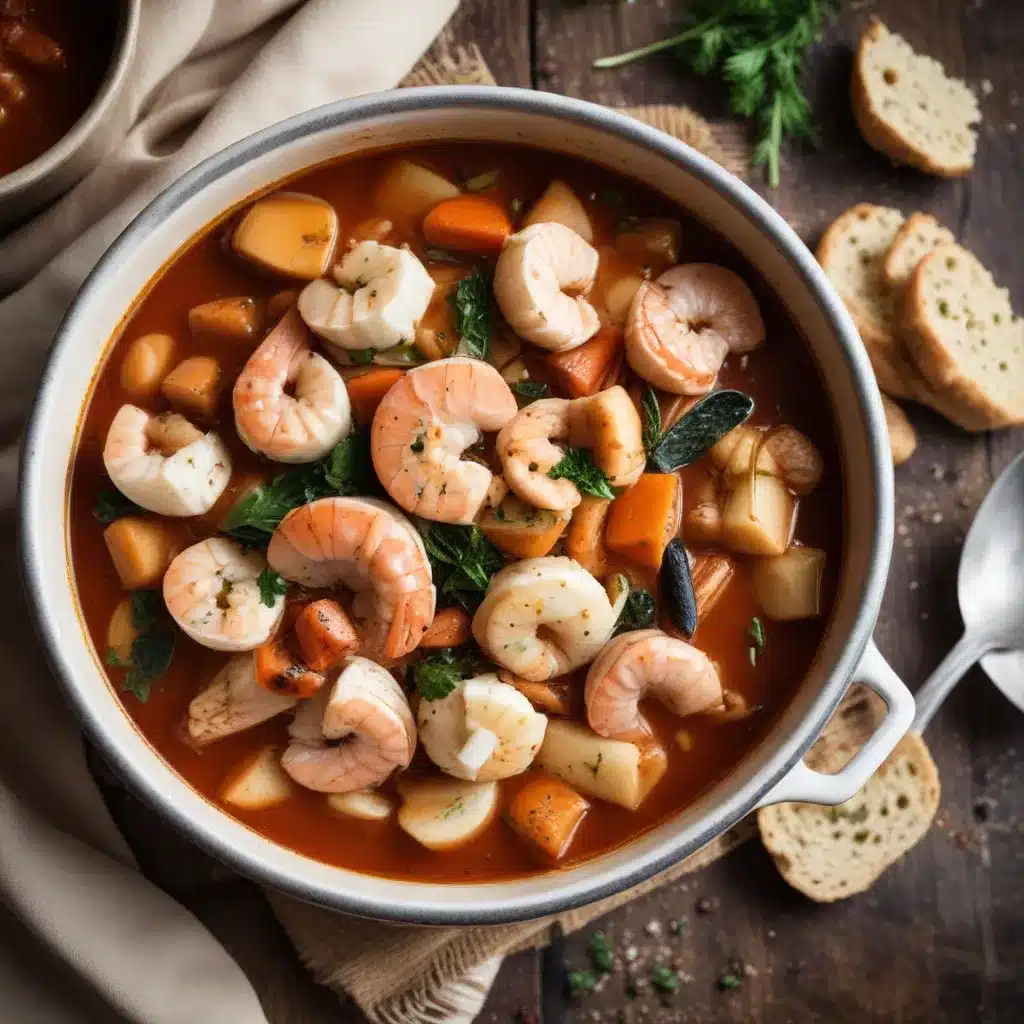
The ocean’s bounty offers a wealth of flavors and nutritional benefits, and when combined with gluten-free ingredients, the possibilities for delectable seafood stews are seemingly endless. As an expert at Fish Tales Cafe, I’m excited to dive into the world of gluten-free seafood stews, exploring the diverse culinary traditions, cooking methods, and health considerations that make these dishes a standout choice for any seafood enthusiast.
Seafood Varieties
At the heart of any exceptional seafood stew lies the seafood itself. While cod is a classic choice, a wide range of other fish and shellfish can be equally impressive. Consider incorporating tender halibut, succulent shrimp, briny mussels, or even delicate scallops into your gluten-free seafood stew. The key is to select the freshest, highest-quality seafood available and to balance the flavors and textures of the different proteins.
Gluten-Free Ingredients
For those following a gluten-free diet, navigating the world of seafood stews can be a delightful challenge. Thankfully, there are a variety of gluten-free ingredients that can be used to create flavorful and satisfying stews. Opt for tamari or coconut aminos in place of traditional soy sauce, and use cornstarch or arrowroot powder as thickeners instead of wheat-based flours. Experiment with gluten-free pasta or rice noodles to add heartiness to the dish, or try quinoa or cauliflower rice for a low-carb option.
Stew Preparation Methods
When it comes to preparing gluten-free seafood stews, the key is to focus on gentle cooking techniques that preserve the delicate flavors and textures of the seafood. Simmering the stew on the stovetop allows the flavors to meld together, while braising the ingredients in the oven can result in a more robust, slow-cooked flavor. For a hands-off approach, try slow-cooking the stew in a crockpot or sous vide the seafood for a perfectly tender and juicy result.
Nutritional Considerations
Seafood stews are not only delicious but also nutritious, making them an excellent choice for health-conscious diners. The protein content from the seafood provides a solid foundation, while the addition of vegetables, herbs, and spices further enhances the nutritional profile. Seafood is also a rich source of omega-3 fatty acids, which have been shown to support heart health and cognitive function. Plus, by opting for gluten-free ingredients, you can tailor the stew to accommodate dietary restrictions while still enjoying all the benefits of a well-balanced meal.
Flavor Profiles
The beauty of seafood stews lies in their versatility, allowing you to explore a wide range of flavor profiles. Incorporate aromatic herbs like thyme, rosemary, or oregano to create a distinctly Mediterranean vibe, or turn to Asian-inspired spices like ginger, lemongrass, and fish sauce for a more exotic twist. The broth can also be tailored to your preferences, from a rich, tomato-based broth to a light, briny seafood stock.
Dining Experiences
Gluten-free seafood stews are not just for the home cook; many restaurants and catering services have embraced this culinary delight. Diners can indulge in the comforting flavors of a clam chowder or a bouillabaisse at their favorite seafood-focused establishments, while those hosting events can impress guests with a visually stunning and delectable cioppino or seafood gumbo. For the home cook, the joy of crafting a gluten-free seafood stew lies in the ability to customize the flavors and ingredients to suit your personal tastes.
Cultural Influences
Seafood stews have deep roots in various culinary traditions around the world. From the Mediterranean region’s beloved cacciucco to the Asian staple of Korean jjamppong, these dishes showcase the ingenuity and diversity of seafood-based cuisine. In Latin American countries, ceviche and moqueca offer a tantalizing blend of citrus, herbs, and fresh seafood. Exploring these cultural influences can inspire new flavor combinations and techniques for your gluten-free seafood stew creations.
Dietary Restrictions
For those with dietary restrictions, such as celiac disease or gluten sensitivity, gluten-free seafood stews provide a delicious and safe option. By carefully selecting the right ingredients and preparation methods, these dishes can be enjoyed without the worry of cross-contamination or adverse reactions. Additionally, seafood is a naturally gluten-free protein source, allowing you to indulge in the rich flavors and textures of a seafood stew without compromising your dietary needs.
Sustainability Factors
As conscious consumers, we also have a responsibility to consider the environmental impact and sustainability of the seafood we choose. Opt for ethically sourced and sustainably caught seafood, ensuring that your seafood stew not only tastes delicious but also aligns with your values. Additionally, minimize food waste by utilizing every part of the seafood, such as incorporating fish bones or shellfish shells into the broth for maximum flavor and efficiency.
Cooking Techniques
Mastering the art of gluten-free seafood stew preparation involves a range of techniques. Simmering the stew at a gentle heat allows the flavors to meld and the seafood to become tender, while thickening the broth with cornstarch or arrowroot powder can create a luxurious, velvety consistency. Proper seasoning with a combination of salt, pepper, and fresh herbs is crucial for balancing the flavors and highlighting the natural sweetness of the seafood.
Whether you’re a seasoned seafood enthusiast or a novice in the kitchen, exploring the world of gluten-free seafood stews is a culinary adventure worth embarking on. By embracing the diverse array of seafood options, experimenting with gluten-free ingredients, and drawing inspiration from global culinary traditions, you can craft a truly exceptional and nourishing dining experience. So, dive in and start exploring the depths of gluten-free seafood stews today!

